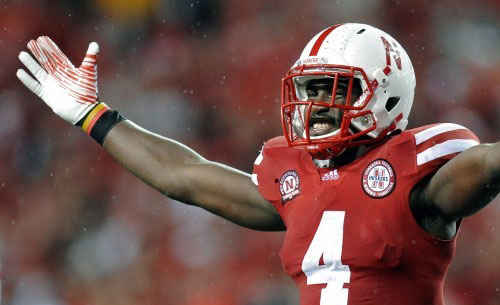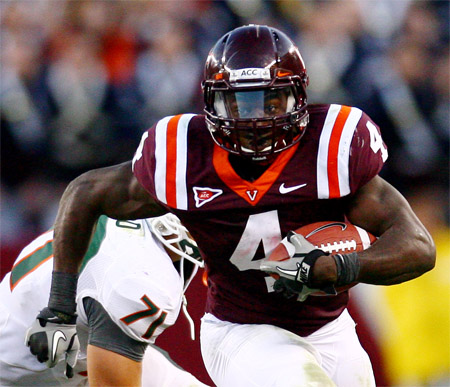
Von Miller had 11.5 sacks as a rookie, but also played well against the run
When I wrote a piece exploring how Courtney Upshaw or Melvin Ingram could be used as a hybrid DE/OLB ‘elephant’, it received a mixed response. Some agreed, others not so much. I still believe the Seahawks intend to draft a pass rusher in the first round, and that they’ll want that player to have an impact immediately. I wanted to look at two successful first round picks from last year to try and determine what it is exactly Seattle is looking for.
I found this article, published by Derek Pease just before week 16. It detailed different statistics for Aldon Smith (7th overall pick for San Francisco) and Von Miller (2nd overall pick for Denver). Neither team runs a defense directly comparable to Seattle’s 4-3 under/hybrid – Denver’s is closer to an orthodox 4-3 while the 49ers are a pure 3-4. Even so, the way the two teams used their first round picks is still interesting.
Smith had 14 sacks as a rookie, just 0.5 away from the NFL record for a first-year pro. He achieved that number playing largely in a nickel role, taking just 446 snaps prior to week 16 compared to Von Miller’s 823. Pease: “Could Smith have challenged Miller for Defensive Rookie Of The Year honors if he was a player with an every-down role? Or have the 49ers maximized his potential by limiting him to nickel situations and not putting him in bad spots (against the run) where he might struggle?”
It’s an interesting concept, and there are similar players in the 2012 draft class who could deal with the same issues. Illinois pass rusher Whitney Mercilus isn’t great against the run, but he showed in 2011 he can get to the quarterback. I’ve had real difficulty working out Mercilus this year – he’s a bit of an enigma. You can’t argue with the production, but the tape doesn’t flash a consistently dominating pass rusher. Yet he still made plays. I’ve seen him struggle at times to disengage against tight ends, but he’s also shown the ability to set up a tackle and work to develop an opening. Very few college pass rushers have that in their locker.
If the Seahawks took a player like Mercilus, they wouldn’t want him playing the edge opposite Clemons – two under sized defensive ends would be asking for trouble. They also want to keep Red Bryant at end, given he’s now the highest paid defensive player on the roster. Just like Aldon Smith, a prospect like Mercilus would be limited as a rookie to nickel pass rushing situations. The big question would be whether he’d have enough snaps to utilise the talent just emphasised – to set up a tackle and work out a way to the QB. Is he explosive enough – as Smith proved – to be an impact pass rusher on obvious passing downs? Would there still be a way for Seattle to manufacture pressure? San Francisco would use Justin Smith to take out two blockers, having Aldon Smith hook around the team’s defensive MVP to exploit 1vs1 match-ups. He dominated in those situations. The Seahawks could try and do the same behind Bryant and Jason Jones, although obviously neither will ever warrant the same attention as Justin Smith.
The NFL has often been described as a copycat league and it makes sense that teams will be hunting to emulate the success the 49ers had in drafting Smith. The Seahawks had a front row seat in the NFC West to watch how San Francisco regularly churned out an elite pass rush, and they were probably jealous. Raheem Brock is unlikely to be retained, opening up a spot for a specialist pass rusher. If the Seahawks are serious about finding their version of Aldon Smith, it opens up the possibility of drafting a Mercilus, a Vinny Curry or an Andre Branch. Whether that’s their intention remains to be seen.
Seattle’s defense is set up to play strong against the run. Drafting a player who won’t be able to play a large number of snaps because of issues in run defense kind of goes against what the team has been preaching. Although Seattle’s main aim is almost certainly to increase their QB pressure in this draft, are they going to go the specialist route? As successful as San Francisco were with their choice last year, it’s still quite an early pick to spend on a prospect who will feature in about half the team’s defensive snaps as a rookie. Trying to copy the 49ers just doesn’t seem like a very Pete Carroll-type move given the Seahawks penchant for being unique. But it could be an option, particularly if the first eleven picks fall a certain way.
Pease’s breakdown (Aldon Smith)
Total snaps: 446
Run defense: 100
Pass defense: 346
Pass coverage: 37
Von Miller was an every down player for Denver, featuring strongly against both the run and pass. According to Pease, he almost doubled the number of snaps seen by Aldon Smith by week 16 (823 vs 446) and was used fairly evenly across the board. While Smith was guarded against the run, Miller defended the pass just twelve more times than the run (365 vs 353). Pease: “Miller is much more than a one-trick pony, playing nearly every down on defense and handling run-stopping and pass coverage duties with equal aplomb. Together with pass-rush demon Elvis Dumervil, Miller has led the Broncos’ defense back to respectability.”
Imagine the Seahawks do draft an Upshaw or Ingram. Von Miller played defensive end for Texas A&M but always projected to linebacker at the next level. Both Upshaw and Ingram played most of their college snaps at end, but could transition to a more versatile role in the NFL. Look at Pease’s final sentence above and subtract Elvis Dumervil for Chris Clemons, and it’s easy to see how the Seahawks might go in a similar direction.
Of course this is the moment people point out that neither Upshaw or Ingram are Von Miller. Neither will be the #2 overall pick. Neither flashed the scintillating combine performance or had the kind of production Miller enjoyed in college. The thing is, the Seahawks aren’t picking second overall. And although many people expect the #12 pick to provide some kind of elite talent, it’s really just a run-of-the-mill mid-first rounder. Seattle can’t expect to find a Von Miller in that range, but they might be able to find a player who can do the same kind of job, just with a different skill set.
It’s interesting to note that of Miller’s 823 snaps prior to week 16 last season, 13% were in coverage situations. Despite the raw athleticism and high potential to play brilliantly in coverage, not even a fifth of Miller’s snaps before the final two regular season games were in coverage. It’s often a point of contention when discussing Upshaw’s (and even Ingram’s) ability to play a similar role. If the Seahawks are looking for someone who can get to the quarterback (like Miller) but predominantly play well against both the pass and the run, then it’s not such a ridiculous idea. For the 10-15% of coverage responsibility Seattle might be looking at, would it not be possible to manufacture this situation to make it less of an issue? To stop a less mobile DE/OLB such as Upshaw being exploited? Or would you just put that responsibility on the player and live with it for the effectiveness vs the run/pass?
Miller, Upshaw and Ingram are all different players. All have different strengths, all have certain weaknesses. But is it such a ridiculous concept to believe all could play a similar position and role at the next level?
Pease’s breakdown (Von Miller)
Total snaps: 823
Run defense: 353
Pass defense: 365
Pass coverage: 105
Again we go back to the copycat nature of the league. Maybe Seattle is looking for their version of Aldon Smith, or maybe they’re trying to find someone who can play a role loosely similar to Miller in Denver? The NFL is becoming less and less about fitting round pegs into round holes. Teams will look for an edge, a way to do things differently and create a match-up problem. Conventional thinking, particularly when it comes to the pass rush and defensive line, is a thing of the past. Why else are the Seahawks using an undersized DE in space in a four-man front with a giant 330lbs behemoth playing the other end position? It’s the main reason why I think we should expect some ‘thinking outside of the box’ in round one for the Seahawks. What some people consider to be poor scheme fits, might be more realistic than you think. We may not truly understand the role of Seattle’s new rookie until he takes the field.









